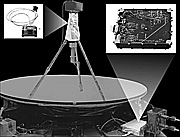 Magnetometer
Magnetometer
NEAR's Magnetometer Investigation (MAG) will conduct the first closeup search for coherent bodywide magnetism at an asteroid. Tantalizing hints of magnetic signatures were detected during Galileo's flybys of Gaspra and Ida, so 433 Eros may have a measurable magnetic field.
Specifications
- Three-axis fluxgate sensor, antenna feed mount
- Electronics: analog sensor circuitry, ranging,
A/D, filters, logic and gate array, DC/DC
- Output sample rate: 80 bits (commandable rate = 0.01-20 Hz)
Nominal rate 1/s: (DC) 0.0-1/s, digital filter
Bandpassed (AC): 1.0-10.0 Hz, rms amplitude
- Eight Ranges:
Full Scale: 4-65, 536 nT
Resolution: 16 bits, (AC: 8 bits log)
- Software: range selection
Digital filtering: anti-aliasing, bandpass
Noise rejection
Command, control, telemetry formatting
- Internal sample rate: 20/s, 20 bits
- Resources: 1.5 kg, 1.5 W, 80 bps
Instruments:

Fluxgate
Sensor & Electronics

Antenna
Dish Assembly
Magnetometer Objectives
Eros is an S-asteroid, representative of the important class which
dominates the inner asteroid belt. Scientists remain uncertain whether S-
asteroids are undifferentiated bodies related to ordinary chondrite
meteorites, or whether they are geochemically processed bodies akin to
stony-irons. The issue is an important test of our understanding of the
connection between asteroids and meteorites. If S-asteroids are unrelated
to ordinary chondrites, then where do these most common of all
meteorites come from? If the two are related, then why don't they look
spectrally identical?
The NEAR magnetometer may also help determine whether small asteroids
are solid fragments of rock with densities like those of meteorite
samples, or whether they tend to be porous piles of collisionally
fragmented rubble with considerable void space. Many meteorites show
measurable magnetization, but if Eros were a randomly re-accreted pile
of fragments, one would not expect a significant coherent bodywide
magnetic field.
Magnetometer Description
To minimize costs and spacecraft impacts, no booms are used. The
sensor is mounted approximately 1 meter from the main spacecraft bus,
on the high gain antenna feed support.
The heritage of this magnetometer includes APL and NASA/GSFC
instruments aboard Voyager, UARS, Geotail, WIND, Freja, Viking,
Pioneer, POGS, Giotto, AMPTE/CCE, Mars Observer, and DMSP. The NEAR
magnetometer sensor mounting configuration is similar to that used on
the successful Giotto mission to Comet Halley.
Incorporated in the design is a complete calibration of the
magnetometer as well as the effect on the instrument of spacecraft
magnetic interference. Using proven methods and the statistics of
nearly a year in orbit, even magnetic signals due to Eros that are
smaller than spacecraft noise can be reliably isolated.
If Eros exhibits small natural remnant magnetization (NRM), the
magnetic sphere of influence will be smaller than the 35-km NEAR
rendezvous orbit, and the strength of the moment must be assessed
indirectly by studying the magnetic perturbations associated with the
Eros bow shock.
For intermediate NRM, the spacecraft may intermittently cross the Eros
magnetopause, and magnetic fluctuation measurements will be used to
assess these events.
For large NRM, the spacecraft will remain entirely within the Eros
magnetosphere for extended periods of time.
Magnetometer Management
- Magnetometer Science Team:
-
Mario H. Acuña (NASA/GSFC), Leader
Christopher Russell, UCLA
- Magnetometer Instrument Scientist:
- Lawrence J. Zanetti (JHU/APL)
- Lead Engineer:
- David A. Lohr (JHU/APL)
- NEAR Payload Manager:
- Robert E. Gold (JHU/APL)
Links to the other NEAR instruments:
Return to Top of this page
Go to NEAR Overview Page
Go to Small Bodies Page
 Return to MSSS
Home Page
Return to MSSS
Home Page